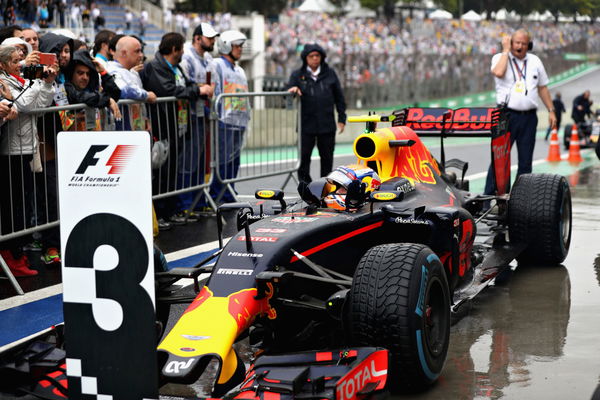
via Getty
SAO PAULO, BRAZIL: Max Verstappen of Netherlands and Red Bull Racing celebrates finishing in third position in parc ferme during the Formula One Grand Prix of Brazil at Autodromo Jose Carlos Pace in Sao Paulo, Brazil. (Photo by Mark Thompson/Getty Images)

via Getty
SAO PAULO, BRAZIL: Max Verstappen of Netherlands and Red Bull Racing celebrates finishing in third position in parc ferme during the Formula One Grand Prix of Brazil at Autodromo Jose Carlos Pace in Sao Paulo, Brazil. (Photo by Mark Thompson/Getty Images)
With high-octane action and cutting-edge technology integrated with mind-blowing speed, there is no doubt that Formula 1 is an attractive sport. In every season, the number of viewers and fans keeps increasing exponentially. Formula 1 never disappoints—not a single race in its history has been boring or deemed ‘ scripted’. Whatever you see is pure speed and raw emotions. However, new fans have complained about the complex rules and terms used in the sport. Words like pitstop, DRS, Parc Ferme, etc. have been slightly confusing for some.
It’s easy to watch the sport and enjoy the thrill. But to know and understand the terms brings appreciation for the sport. It makes fans eager for the next race. Has the term ‘Parc Ferme’ never tickled your mind? We’re sure it has, at some point or another. However, a better, rather simpler, understanding of important motorsport terminology comes in handy. So, here’s everything you need to know about Parc Ferme.
ADVERTISEMENT
Article continues below this ad
What does ‘Parc Ferme’ mean?
First off, ‘Parc Ferme’ is a French term that simply translates to a parking lot. So does this mean it is a parking lot for F1 cars? F1 defines the term as “a fenced-off area into which cars are driven after qualifying and the race, where no team members are allowed to touch them except under the strict supervision of race stewards.” In layman’s terms, it is indeed a parking space for Formula 1 cars. However, this is an extremely secure area, out of reach for even the teams!
After taking the chequered flag, the victory of a driver isn’t a victory unless scrutineers certify it. This scrutinizing takes place in Parc Ferme. The race stewards and a few mechanics enter the restricted area. A detailed check is done. The checks involve using laser technology to measure weight and size and inspecting equipment to verify that parts have pre-tested homologation labels meeting the required standards. This is necessary to scrutinize the legality and safety of the cars.

via Getty
SCARPERIA, ITALY – SEPTEMBER 13: Race winner Lewis Hamilton of Great Britain and Mercedes GP celebrates in parc ferme during the F1 Grand Prix of Tuscany at Mugello Circuit on September 13, 2020 in Scarperia, Italy. (Photo by Mark Thompson/Getty Images)
The FIA controls the sealed-off zone. Nothing can be done to the cars. The mechanics’ job is to shut down the systems with their suitable equipment. They also look into the cooling of the machinery and support the scrutineers throughout the checking process. The FIA rigorously maintains the purity of the sport at Parc Ferme.
So, as you can see, Parc Ferme plays an extremely important role in keeping up with the authenticity of F1. Of course, no team would want their rivals to have an extra edge, so the scrutiny is very vital. That’s not all. We’ve just scratched the surface. More is yet to come!
What’s your perspective on:
Does Parc Fermé make F1 more exciting, or does it stifle teams' creativity and strategy?
Have an interesting take?
What are Parc Ferme conditions?
The mechanics and scrutineers control the Parc Ferme, so no one can do anything to the cars. Meanwhile, in parc ferme conditions, even though teams have the cars, they must treat them as if they are still under FIA control. While Parc Ferme often suggests cars be stored in a garage overnight, in reality, mechanics might work on them or drivers might do qualifying laps. Throughout the race weekend, teams work under Parc Ferme conditions.
Before each team leaves the pitlane for qualifying, the teams must submit a set-up sheet to FIA’s tech team. The set-up they present must be the same from qualifying until the race. However, the regulations allow certain maintenance work. Under no circumstances is one allowed to change or modify any parts of the car. To prevent unauthorized activities, an FIA scrutineer supervises all maintenance work on each car.

via Getty
ABU DHABI, UNITED ARAB EMIRATES – DECEMBER 12: Race winner and 2021 F1 World Drivers Champion Max Verstappen of Netherlands and Red Bull Racing celebrates in parc ferme during the F1 Grand Prix of Abu Dhabi at Yas Marina Circuit on December 12, 2021 in Abu Dhabi, United Arab Emirates. (Photo by Mahmoud Khaled – Formula 1/Formula 1 via Getty Images)
At the start of the weekend, each team checks its own car and declares it legal. To verify this, the FIA randomly checks at least six cars in Parc Ferme after practice. Each team can modify their cars within the rules until the start of qualifying. Once Q1 begins, all the cars are in parc ferme condition until the race starts. Moreover, cars knocked out in Q1 or Q2 stay in the garage under parc ferme and are monitored by a steward.
Cars that go into Q3 go to Parc Ferme at the end of the session for checking purposes. Then they return to the garage under supervision. Post-race, all finishers go to the parc ferme for checking, which can last for around 2 hours. Additionally, the officials confirm the final race result only after these checks, which means they can decide it long after the race ends.
Where is the Parc Ferme located?
A physical Parc Ferme is located at the start of the pit lane, near the FIA garages and the podium. This is to facilitate the podium holders joining the prize-giving ceremony quickly. If the cars are in Parc Ferme, they are under Parc Ferme conditions. Only basic tasks, like shutting down the system and cooling the machinery, are allowed.
More importantly, the cars in Parc Ferme are in good condition throughout the weekend, no matter where they park. At the end of the race, scrutineers might randomly pick a car for inspections, and teams must comply completely and offer the required assistance if any. By now, we’re sure you’ve understood what parc ferme and parc ferme conditions are. Let’s look at the exceptional cases.
In some exceptions, parc fermé rules relax slightly
FIA understands the need for emergency changes in a car in certain cases. Therefore, the Parc Ferme and Parc Ferme conditions come with some relaxation clauses for these occasions. So what are they?
Damaged car under Parc Ferme condition
Repairing ‘genuine damages’ is allowed. Usually, all the damages are genuine. There are two types of damages: one requiring component change and the other requiring full replacement. To replace parts or larger sections, teams must submit a written application to the FIA.

via Getty
HOCKENHEIM, GERMANY – Second place qualifier Max Verstappen of Netherlands and Red Bull Racing celebrates in parc ferme during qualifying for the F1 Grand Prix of Germany at Hockenheimring in Hockenheim, Germany. (Photo by Lars Baron/Getty Images)
Changing weather conditions
If the weather changes, the FIA will announce it and loosen the parc fermé conditions to allow teams to make the necessary adjustments. Of course, the scrutineers will be present at all times to look into the changes.
Recently, officials made major changes to the parc fermé to ensure the safety of the drivers and the dedicated crew. Here’s everything you need to know.
FIA outlined new Parc Ferme protocols after the Ocon incident
Following a risky episode in Baku in 2022, the FIA took more strict measures to implement the Parc Ferme. Esteban Ocon went in for a pit stop in the penultimate lap. Not realizing that the crew would be there at the pit entry setting up the Parc Ferme. Meanwhile, the crew too did not expect a car to turn up in the pitlane on the last lap. After the incident, the stewards and officials decided to make changes to the post-race procedures.
ADVERTISEMENT
Article continues below this ad
The FIA requires teams to keep VIPs and mechanics clear of the pit lane until after the last car finishes, and no more pit stops are expected. The FIA stated: “Team mechanics are not permitted to move from their garages to the parc ferme with cooling fans in anticipation of their cars stopping at the end of the race until after the last car has taken the chequered flag.” Moreover, personnel and VIPs must not enter the pit lane until the last car has taken the checkered flag. Lastly, any infringement will result in the removal of passes from the team(s) in question from subsequent events and the potential reporting of the infringing team(s) to the stewards.
Lastly, let’s now see why the Parc Ferme is necessary.
ADVERTISEMENT
Article continues below this ad
Why does FIA need the Parc Ferme?
The Parc Ferme and the Parc Ferme conditions play a very important role in maintaining the authenticity of F1. Through strict procedures, the FIA ensures fairness and safety. The idea, although simple, weighs more in importance and relevancy. Without parc fermé, officials would never detect a team implementing unauthorized changes to gain an advantage. Changing car components for an advantage during the race is unfair and unsportsmanlike. Parc Ferme ensures fairness in Formula 1, emphasizing driver skills over deceitful tactics.
So now, hopefully, you know a bit more about Parc Ferme than you did before. We often fail to realize how important certain rules and regulations are in Formula 1. But now, the understanding is slightly better than before. And with that, we’ve come to the end of our discussion. Hopefully, when you watch the next, you’ll learn what a Parc Ferme is and how the Parc Ferme conditions work! What is your take on this topic? Share your thoughts in the comments.
ADVERTISEMENT
ADVERTISEMENT
ADVERTISEMENT
ADVERTISEMENT


Does Parc Fermé make F1 more exciting, or does it stifle teams' creativity and strategy?